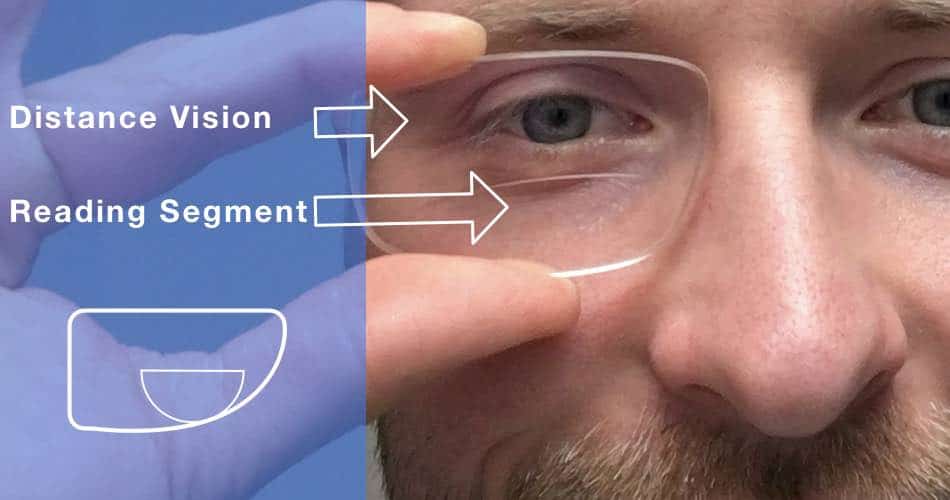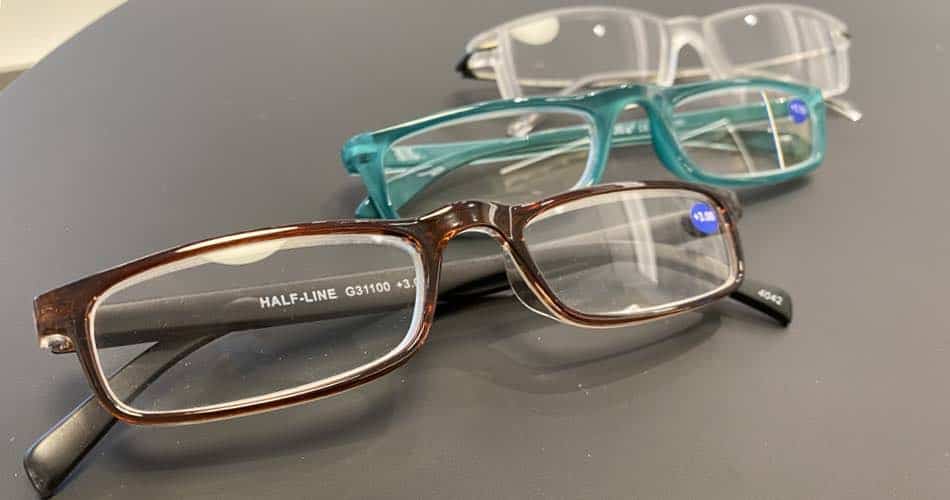When the world turns into a blurry blob, and you can’t read the words on a page in front of you, it’s time to take a trip to the optometrist for some new glasses. There are two predominant types of glasses for the farsighted person: reading glasses and bifocals. But what’s the difference, and how can you tell which type is for you?
The difference between reading glasses and bifocals is the structure of the lenses. Reading glasses have a single vision lens that is strictly designed for near vision, whereas bifocal lenses comprise different strengths for both near and distance vision.
Read on to learn more about the differences between reading glasses and bifocals, in addition to the different types of lenses each can have and how to determine which is right for you.

Structural Difference Between Reading Glasses and Bifocals
Perhaps the most obvious differences between reading glasses and bifocals are in physical appearance. Up next, we’ll discuss how these life-changing inventions are uniquely structured and different to suit various vision concerns.
Structure of Reading Glasses
Reading glasses are comprised of a single vision lens within a metal, plastic, or mixed frame. This single vision lens makes these glasses unique because they are strictly designed to aid in farsighted vision. This means that an individual can see things perfectly at a distance but will have blurred vision for nearby objects directly in front of them.
Since the lenses in reading glasses are single vision, they are comprised of one unified strength throughout the entire lens. Additionally, single vision lenses on reading glasses tend to be convex (or curved outward) in shape. In addition to its single vision, this shape in the lens allows near objects to appear clearer to the user.
The lens’s power will vary by individual and depends on the degree of visual aid they require. Typically, low-power reading glasses will fall into the range of +1.25 to +1.5. This is for activities where the object is close but not directly in front of your face, such as typing on a computer.
When you are in your 40s you will be fine reading and doing PC work with this Add value. However, over time, this Add value needs to be increased. Then reading will typically require stronger powered glasses in the range of +2.0 to +2.5.
Although your lens’s power might start at +1.25, it is typical for vision to degenerate with age. Reading glasses are commonly used by individuals with presbyopia. This is an age-related eye condition that causes increased rigidity of the eye’s lens, ultimately decreasing a person’s near vision. Therefore, you will likely need to upgrade to more powerful lenses incrementally throughout your life.
Structure of Bifocals
Despite their similarities in purpose, bifocals differ significantly from reading glasses, particularly in structure. As opposed to the single vision lenses of reading glasses, bifocal lenses comprise different strengths that allow them to be more versatile and appropriate for wearing over extended periods.

When you think of bifocals, it might conjure an image of Benjamin Franklin in his half-moon glasses. Although most bifocals don’t look like this today, it does help provide a visual of how they are structured.
Bifocals have different strengths because each lens is actually comprised of two different lenses with separate powers.
The majority of the lens is clear and free of magnification to allow the user to see objects in the distance without issue. This is mainly because individuals who use bifocals are farsighted and have no issue seeing things that are far away, so they don’t need optical assistance for this task.
The second lens is a small, crescent shape towards the bottom of the lens that allows the reading to switch from distance perception to near perception.
These lenses provide the same benefits as reading glasses when it comes to visual clarification of near objects. One of the most significant differences is that if you are wearing reading glasses and want to see something far away, you would have to remove your glasses.
Different Types of Reading Glasses and Bifocals
Of course, some of the difference between these two kinds of glasses is in the available types. Here’s we’ll outline the various types of reading glasses and bifocals, as well as what they’re used for.
Types of Reading Glasses
There are two types of reading glasses you can acquire: prescription reading glasses and over-the-counter reading glasses. Both can help you achieve the same goal of seeing near objects more clearly, but they have different acquisition processes.
Prescription Reading Glasses
To obtain prescription glasses, you will need to consult with an expert, such as an optometrist, to conduct various vision tests and ocular examinations to determine the exact lens power you will need for your glasses.
This process eradicates the trial and error you would be subjected to at an over-the-counter location. Prescription reading glasses are also beneficial for individuals that might suffer from ocular diseases such as myopia or astigmatism, which would require specific variations in their lenses to counteract side effects and provide optimal vision.
Over-the-Counter Reading Glasses
It is far easier to obtain over-the-counter reading glasses, which are typically found in pharmacies and discount or retail stores.
Although you don’t need a specialist to buy glasses at these locations, it is still recommended that you consult an eye specialist before buying new reading glasses. A specialist can help you gauge what power you need and ensure that you don’t have any underlying issues that might be impairing your vision or cause further complications.
Typically, individuals that buy over-the-counter reading glasses are only slightly visually impaired and just need a little boost to perform daily tasks more efficiently. Fortunately, you can buy over-the-counter reading glasses at a fraction of the cost of prescription reading glasses.

Over-the-counter reading glasses can be easily acquired for $5-$25, whereas prescription reading glasses might cost anywhere from $25-$800 depending on the severity and complexity of your vision.
Types of Bifocals
There are also various types of bifocal lenses individuals can incorporate into their glasses to assist them with specific daily tasks, such as computer work.
All bifocals have the same purpose, but some can be created with different types of lenses to further enhance an individual’s vision and cater to their needs.
Several determining factors regarding which type of bifocal lenses you would use, such as the amount of time you wear them daily, if you have any significant optical diseases, and your specific needs for lens power.
Traditional Bifocals
The lenses of traditional bifocals are fairly simple and identifiable in design. As mentioned previously, the majority of the lens is a clear and unmagnified lens, and only about the bottom fourth is comprised of a separate crescent magnified lens for near vision.
This lens is distinguishable by a sharp line dividing the two separate lenses, which would allow anyone to discern that the glasses are bifocals.
Progressive No-Line Lens Bifocals
Many individuals opt for progressive no-line bifocal lenses because, as the title describes, these lenses are built without that distinguishable line staple to traditional bifocals.
Another benefit of these lenses is that they are built from a single lens instead of two separate lenses found in traditional bifocals. The top, clear section of the lens gradually shifts into the lens’s magnified bottom section through an intermediate magnification section in the middle.
This structure helps ensure a more gradual shift in magnification, allowing the user to perceive various focal points more easily.
Therefore, these lenses are best suited for individuals that prefer to wear their glasses throughout the day because they provide the most versatility.
Computer-Style Progressive Lens Bifocals
These bifocals are the most beneficial for individuals who find themselves stuck in front of a computer for hours every day. Computer-style progressive bifocals are created specifically for people who often read off monitors and screens, such as Smartboards, computers, cell phones, and tablets.
Similar to the progressive no-line bifocal lenses, computer-style progressive lenses are created from one, uniform lens. The most significant difference is that the top section of a computer-style progressive lens is not clear and unmagnified.
On the contrary, it offers intermediate range-viewing with a 60% magnification strength. This is perfect for slightly enhancing and clarifying text on a screen without blowing it up to over-sized proportions.
The bottom of the lens is structured for 100% magnification, suitable for reading small text. This could be something small on the screen or directly in front of you. These lenses are also created with unique anti-reflective coating to limit the visual strain of electronic screen glare and artificial lights.
Structurally, these glasses are a little less versatile than the progressive no-line bifocals mentioned above. They are exceptional for deskwork but, similarly to reading glasses, they are designed specifically for near tasks and would likely obscure your vision of distanced objects.
However, without visual assistance, staring at electronic screens on a frequent basis could cause significant eye strain, and so, these bifocals are highly recommended for this line of work.
How Can I Tell Which One is For Me?
Now that you know the difference between reading glasses and bifocals, it is time to determine which type of glasses is best for you. Remember that every individual has their own unique vision, which is likely to change over time.
When you are young or middle-aged, you might start with reading glasses, which you only wear occasionally for work or school. But over time, you might realize you need to shift to more versatile bifocals for daily use.
Refer to the chart below to see which defining factors apply to you and what glasses apply to each factor.
| Defining Factor | Reading Glasses | Bifocals |
| The user is nearsighted | X | |
| The user is farsighted | X | X |
| Individuals with presbyopia | X | X |
| Can be worn all day no matter the task | X | |
| Allows users to switch from near to far perception | X | |
| The user prefers to wear glasses for short periods | X | |
| ADD prescription (ADDitional power) | X | X |
| Best suited to individuals under 40 | X | X |
| Best suited to individuals over 40 | X |
Signs You Need Reading Glasses or Bifocals
Sometimes it’s difficult to determine when you’ve passed that point of no return and need to finally invest in a pair of reading glasses or bifocals. To some, this feels like an admittance of old-age and defeat, but don’t be discouraged; you’re not alone.
The Vision Impact Institute determined that 3 out of 4 individuals use some form of vision correction in America alone. Of those individuals, 71% wear glasses, and 22% wear contacts.
When you notice you are experiencing difficulties with your vision, it’s best to seek help. If you are experiencing multiple signs mentioned below, consult an eye-care professional about receiving reading glasses or bifocals as soon as possible.
Common Signs You Should Acquire Reading Glasses or Bifocals
- Frequent headaches when reading
- Daily eye fatigue
- Regular eye strain that is uncomfortable, painful, or debilitating
- Constantly moving objects away from you to increase vision and readability
- Vision and focus changes throughout the day (near objects are clear in the morning but blurry by the end of the day)
- The blurriness of near objects and clarity of distanced objects
- Often need bright lights to see or read properly
- Frequently losing your place when reading and/or using finger guides
If you are experiencing many of these signs on a day-to-day basis, or you notice some occur much more frequently than normal, consider taking a simple eye test at home and then consulting an eye-care professional for additional help.
Signs Your Glasses Aren’t a Good Fit
Transitioning to new reading glasses or bifocals can be an uncomfortable process, especially if you’ve never needed visual aid before. The length of this transition period varies depending on how often you are using your glasses or bifocals. If you use them daily, it might take a few days, whereas, if you use them infrequently, it could take one to two weeks.
However, there are several signs you should be aware of that might indicate your new pair of reading glasses or bifocals aren’t the proper fit for you. If you are experiencing any of the signs listed below, it is advised that you consult an eye-care professional about transitioning to a different pair. The problem could be as simple as improper lens power or as concerning as an undiagnosed optical disease.
Signs You Should Change your Reading Glasses or Bifocals
- Frequent eye-rubbing
- Eye fatigue or strain that does not improve with use
- Still distancing objects to see them clearly
- Regular headaches
- Seeing halos of light
- Frequently applying and removing reading glasses (might imply your lifestyle is better suited for bifocals)
It is important to use your reading glasses or bifocals frequently to prevent further eye-strain, as well as quickly determining if they are a proper fit for your vision and lifestyle. If you notice you are experiencing any of these signs, especially 2+ weeks after acquiring your new glasses or bifocals, it is best to seek professional assistance.

Effects of Not Wearing Glasses
Blurred vision might be annoying to squint through, but there are several other, more serious consequences of not using visual aid when necessary.
It is impossible for someone to function at 100% of their visual potential if they choose not to wear their glasses or bifocals. This could seriously risk the health of the visually impaired person and others around them.
For instance, if a farsighted individual constantly strains their eyes to read and focus on objects close to them, they will significantly increase their chances of fatigue, headaches, and stress.
Now, put that person in a car. Yes, a farsighted person could see the car down the street. But, as a result of their impaired vision, they will likely have difficulty reading their speedometer or judging the distance between themselves and the car directly in front of them. This increases their chance of accidents and collisions where they could injure themselves and potentially others.
Additionally, refusing to use the necessary visual aid could have long-term effects on eye development. Without a clear image reaching the retina, eyes are likely to have incomplete development because they are constantly working too hard to see properly and rarely receiving clear visuals.
These risks are especially concerning in children who are far more likely to injure themselves during daily tasks by tripping or falling into objects. Another concern, apart from delayed or incomplete eye development, is the likelihood that a child without some form of reading glasses (in some cases they are needed early on) will struggle academically and dislike reading because it is visually straining.
It is always recommended to have regular eye exams to ensure you have visual aid available when necessary. It is vital to use the aid whenever the situation calls for it, for your own safety and those around you.
Final Thoughts
It is not uncommon to assume that reading glasses and bifocals are essentially the same. Although they have the same overall function of assisting farsighted individuals, they have significant differences in lens structure and versatility.
Single-lens reading glasses are best suited for long-term near tasks, whereas bifocals offer more versatile visual aid for near and far vision.
A person’s vision is as integral to their health as any other part of the body. Therefore, it is recommended that all individuals have routine eye exams to guarantee optimal vision. Not only will a professional eliminate the dilemma of choosing between reading glasses and bifocals, but they will also ensure you receive the proper strength and lens structure to suit your daily needs.
I wish you a great day.
